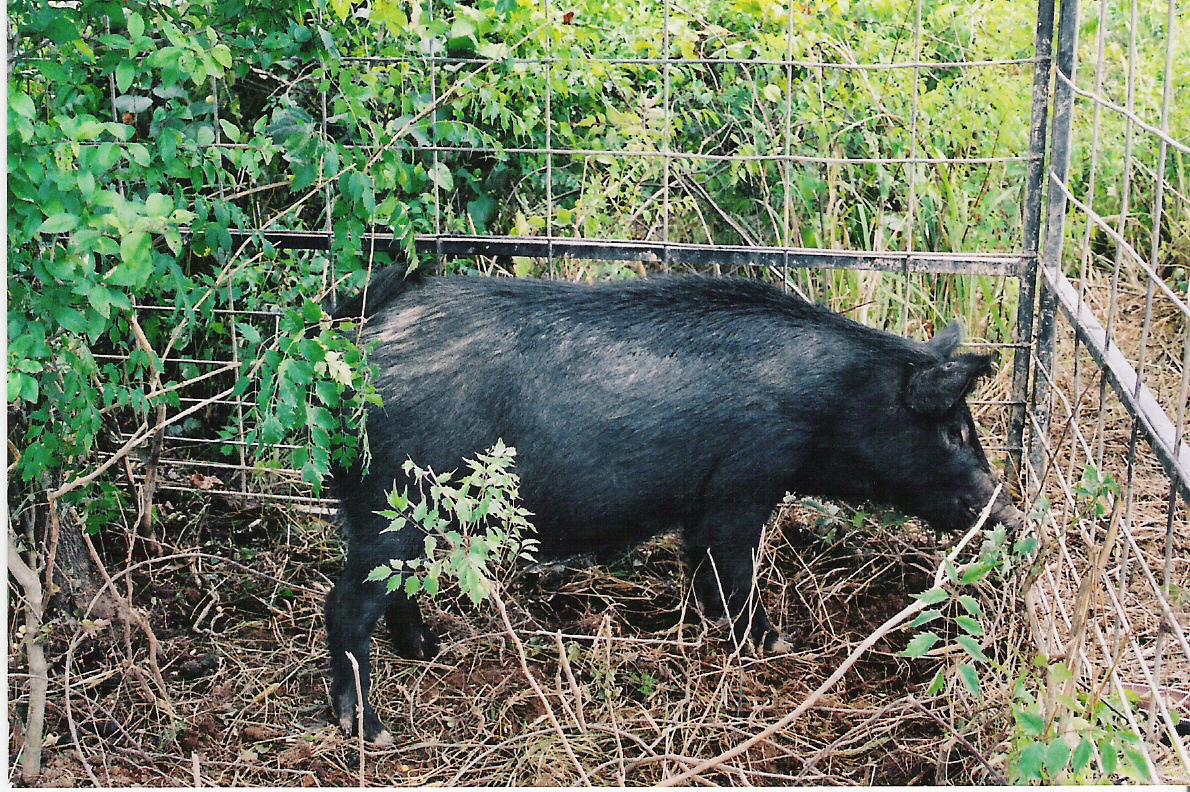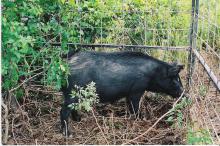Information Possibly Outdated
The information presented on this page was originally released on May 17, 2007. It may not be outdated, but please search our site for more current information. If you plan to quote or reference this information in a publication, please check with the Extension specialist or author before proceeding.
MSU scientists study wild hog management
By Andrea Cooper
MSU College of Forest Resources
MISSISSIPPI STATE -- Feral hogs have perhaps the worst reputation of any wild game animal in the nation, and Mississippi State University researchers hope to gain the upper hand by studying their habitat and populations.
While hunters enjoy pursuing these elusive and dangerous animals, most landowners view wild hogs as nuisances because of their extremely destructive foraging habits.
“One of the primary problems with feral hogs is that they root through the soil in search of food, causing various problems in both agricultural and natural settings,” said Sam Riffell, MSU wildlife and fisheries assistant professor. “This type of behavior can cause soil erosion, destroy native plant communities, reduce nesting cover and available forage for other wildlife species, and cause economic damage to crops.”
In addition to consuming vegetation, feral hogs carry diseases that can be passed on to livestock, humans and other wildlife.
To determine ways to better manage feral hogs, Riffell and graduate student Clay Hayes initiated a research project through the university's Forest and Wildlife Research Center.
Hayes, a native of Milton, Fla., examined the home range, habitat use and survival of 29 feral hogs in central Mississippi. From April 2005 through April 2006, Hayes trapped and radio-collared the hogs and then located them two to three times per week using radio telemetry.
“Our study found that several factors influence the preferred habitat of wild hogs,” Hayes said. “First, because hogs have no sweat glands, they prefer moist areas during hot weather and may become primarily nocturnal during the hottest parts of the year.”
Other factors include food availability and a need for cover, Hayes added.
Sponsored by the Mississippi Department of Wildlife, Fisheries and Parks, the Mississippi Agricultural and Forestry Experiment Station and the Berryman Institute at MSU, the study revealed that rainfall also influences home range size. In general, the home ranges in this study were larger during the dry season than the wet, possibly due to seasonal flooding of some areas within the home range.
“Understanding the home range of feral hogs is important for minimizing negative interactions between feral hogs and native wildlife,” Hayes explained. “Managers need to know what types of habitat the hogs are using, as well as how large an area they roam.”
At the end of the year-long study, 14 of the 29 radio-collared hogs were still alive. Hunting or trapping was the cause of mortality for 12 of the 15 that did not survive.
“Hunting, trapping and harassment may be the best tools managers and landowners have to reduce damage to sensitive areas,” Hayes said. “Private landowners may legally take hogs on their property at any time of the year, whereas state wildlife management areas have seasons.”
Hogs tend to move from areas where they are heavily disturbed into more peaceful surroundings. For this reason, the MSU researchers found that hunting with dogs may be particularly effective if the object is to remove a few animals and cause the remaining ones to relocate.
“Hunting feral pigs is usually relatively safe because these animals are elusive and have excellent senses of hearing and smell, but if you wound one, corner one or happen upon a sow with young, watch out,” Hayes said. “Because of their size, speed and tusks, wild hogs can be quite formidable and dangerous.”
Hunting with dogs bred and trained for hog hunting is usually safest, he added, but dogs used to hunt wild hogs should be equipped with heavy vests to limit chances of injury. Larger caliber (above .243) repeating rifles are best because the bullet must penetrate a tough hide, a lot of muscle and quite a bit of cartilage around the shoulders.
“If you happen upon a feral hog unarmed, try not to spook it,” Riffell warned. “Because they have poor eyesight, they may run over you if panicked. It is best to back away slowly.”
Other wild-hog-related research being conducted at MSU includes a human dimensions study by Edith Parks, a graduate student under the guidance of assistant professor Kevin Hunt. Her work includes a survey to determine the distribution of feral hogs and attitudes towards them.
Rich Minnis, an assistant research professor, is conducting a study on avian influenza in duck and hog populations around the state. Research of feral hogs by MSU's Department of Wildlife and Fisheries also is expanding into the Mississippi Delta.
“Though feral hogs are widespread and extremely damaging to natural and agricultural habitats, current knowledge is comparatively limited,” Riffell said. “Through studies like these, scientists provide a stronger foundation upon which to base management decisions.”
Contact: Dr. Sam Riffell, (662) 325-0392





